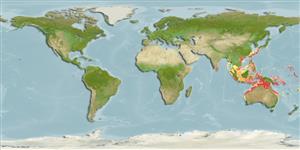Environment: milieu / climate zone / depth range / distribution range
Ecology
Marine; demersal; depth range 10 - 75 m (Ref. 11790). Tropical
Western Pacific: South China Sea to the Indo-Australian Archipelago (including Western Australia).
Size / Weight / Age
Maturity: Lm ? range ? - ? cm
Max length : 40.0 cm SL male/unsexed; (Ref. 9774); common length : 25.0 cm SL male/unsexed; (Ref. 9774)
Inhabits shallow water (10 m) on mud and sand bottoms of coastal zones (Ref. 9774) to a depth of 150 m (Ref. 9494). Feeds on small benthic animals (Ref. 9774). Caught mainly with prawn trawls (Ref. 9774). Marketed fresh and considered a good food fish.
Life cycle and mating behavior
Maturity | Reproduction | Spawning | Eggs | Fecundity | Larvae
Distinct pairing (Ref. 205).
Allen, G.R. and R. Swainston, 1988. The marine fishes of north-western Australia: a field guide for anglers and divers. Western Australian Museum, Perth. 201 p. (Ref. 3132)
IUCN Red List Status (Ref. 130435: Version 2024-1)
Threat to humans
Harmless
Human uses
Fisheries: commercial
Tools
Special reports
Download XML
Internet sources
Estimates based on models
Preferred temperature (Ref.
123201): 24.6 - 28.8, mean 27.7 °C (based on 564 cells).
Phylogenetic diversity index (Ref.
82804): PD
50 = 0.5000 [Uniqueness, from 0.5 = low to 2.0 = high].
Bayesian length-weight: a=0.00724 (0.00338 - 0.01553), b=3.17 (3.00 - 3.34), in cm total length, based on LWR estimates for this Genus-body shape (Ref.
93245).
Trophic level (Ref.
69278): 3.5 ±0.37 se; based on food items.
Resilience (Ref.
120179): Medium, minimum population doubling time 1.4 - 4.4 years (Preliminary K or Fecundity.).
Fishing Vulnerability (Ref.
59153): Moderate vulnerability (39 of 100).
